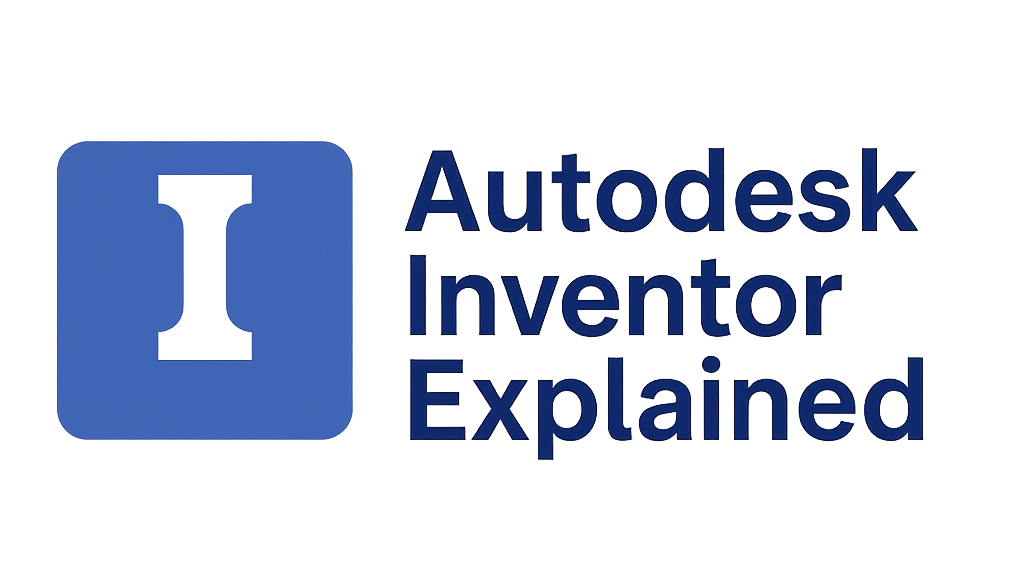Autodesk Inventor Explained
Professional-Grade 3D Mechanical Design and Digital Prototyping
Introduction to Autodesk Inventor
Autodesk Inventor is a professional-grade 3D CAD software used for mechanical design, documentation, and product simulation. As a cornerstone of Autodesk’s manufacturing solutions, Inventor provides a comprehensive set of tools specifically tailored for engineers and designers who create machinery, mechanical parts, and complex assemblies. It enables a “Digital Prototyping” workflow, allowing users to design, visualize, and simulate products before they are built.
Core Principle: Parametric Modeling & Associativity
Inventor is built on a robust, history-based parametric modeling engine:
- Parametric Design: Dimensions, constraints, and relationships drive the geometry. This “design intent” is captured so that when a dimension is changed, the model intelligently updates.
- Feature-Based History: 3D models are constructed from a sequence of building-block features (Extrude, Revolve, Fillet, etc.) that are recorded in a browser tree. This history can be edited at any point to modify the design.
- Full Associativity: A change to a part model automatically propagates to all assemblies where it is used and updates all related 2D drawing views, dimensions, and bills of materials.
This ensures consistency across all project deliverables and significantly reduces manual rework and errors.
3D Part & Assembly Model
2D Manufacturing Drawing
Change the model, the drawing updates automatically.
Key Capabilities & Environments
Inventor provides a rich toolset across several integrated environments.
Part Modeling
A comprehensive suite for creating 3D mechanical parts using parametric, direct, freeform, and rules-based (iLogic) design tools.
Assembly Design
Powerful tools for creating and managing large, complex assemblies, applying constraints, analyzing interferences, and creating exploded views.
Drawing & Documentation
Automated creation of detailed, standards-compliant manufacturing drawings, complete with dimensions, annotations, and Bills of Materials (BOM).
Sheet Metal Design
A dedicated environment for designing sheet metal parts with features like flanges, bends, and punches, and creating flat patterns for manufacturing.
Frame Design & Weldments
Tools for rapidly creating and analyzing structural frames from standard library profiles and documenting weldments.
Simulation & Analysis
Integrated tools for stress analysis (FEA), dynamic simulation (motion analysis), and frame analysis to validate design performance.
Tube & Pipe Design
Rules-based routing of rigid tubes, flexible hoses, and pipes in complex assemblies.
Cable & Harness Design
Tools for designing and documenting electrical cable and wire harness routes within a 3D mechanical assembly.
Factory Design Utilities
Part of the Product Design & Manufacturing Collection, these tools help create and visualize digital models of factory layouts.
Differentiating Features & Technologies
iLogic Design Automation
A powerful rules-driven design environment that allows users to capture knowledge and automate repetitive design tasks without needing to be an expert programmer.
AnyCAD Technology
Allows for associative linking of non-native CAD data (from systems like SolidWorks, Creo, NX) directly into Inventor assemblies without file translation, maintaining a link to the original file.
Model-Based Definition (MBD)
Robust tools for embedding manufacturing information, dimensions, and tolerances directly onto the 3D model, enabling a streamlined, drawing-less workflow.
Integration with Autodesk Vault
Deep integration with Autodesk’s PDM software for managing design data, tracking revisions, and controlling access for teams.
Advantages & Disadvantages
Advantages
- Powerful and stable parametric modeling engine.
- Comprehensive toolset specifically for mechanical design.
- Excellent for large assembly management.
- Strong automation capabilities with iLogic.
- Good interoperability with other CAD formats via AnyCAD.
- Deep integration with other Autodesk products (AutoCAD, Fusion 360, Vault).
- Robust 2D drawing and documentation environment.
Disadvantages
- Primarily a desktop, file-based application (less native cloud collaboration).
- Subscription cost can be significant for individuals/small teams.
- Learning curve can be steep for beginners.
- Advanced surfacing capabilities are generally considered less powerful than high-end competitors like CATIA or NX.
- Windows-only platform.
Who Uses Autodesk Inventor?
Inventor is the tool of choice for professionals focused on mechanical design and machinery:
Inventor vs. SolidWorks & Fusion 360 (Brief)
| Aspect | Autodesk Inventor | SolidWorks | Fusion 360 |
|---|---|---|---|
| Core Strength | Robust Mechanical & Automation (iLogic) | Ease of Use, Large Community | Integrated Platform, Cloud Collaboration |
| Platform | Desktop (Windows) | Desktop (Windows) | Cloud-Based (Desktop Client) |
| Interoperability | Excellent (AnyCAD) | Good (3D Interconnect) | Good (AnyCAD) |
| Ecosystem | Strongly integrated with Autodesk suite | Large third-party partner network | Cloud-first, constantly evolving |
The Professional’s Choice for Digital Prototyping
Autodesk Inventor is a powerful, mature, and comprehensive solution for professional mechanical design. Its robust parametric engine, strong large-assembly performance, and specialized toolsets for tasks like frame and sheet metal design make it a go-to choice for engineers creating complex machinery and products. Through its digital prototyping capabilities, Inventor empowers users to design, visualize, and simulate their creations with confidence, reducing physical prototyping costs and accelerating time to market.

